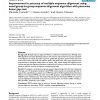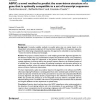194 search results - page 3 / 39 » Gene Sequence Alignment on a Public Computing Platform |
CPM
2004
Springer
13 years 11 months ago
2004
Springer
Abstract. This paper addresses the problem of aligning multiple sequences of non-coding RNA genes. We approach this problem with the biologically motivated paradigm that scoring of...
BMCBI
2006
13 years 5 months ago
2006
Background: Multiple sequence alignment (MSA) is a useful tool in bioinformatics. Although many MSA algorithms have been developed, there is still room for improvement in accuracy...
BMCBI
2006
13 years 5 months ago
2006
Background: With the ever-increasing number of gene sequences in the public databases, generating and analyzing multiple sequence alignments becomes increasingly time consuming. N...
BMCBI
2005
13 years 5 months ago
2005
Background: Alignments of homologous DNA sequences are crucial for comparative genomics and phylogenetic analysis. However, multiple alignment represents a computationally difficu...
BMCBI
2005
13 years 5 months ago
2005
Background: Currently available methods to predict splice sites are mainly based on the independent and progressive alignment of transcript data (mostly ESTs) to the genomic seque...


